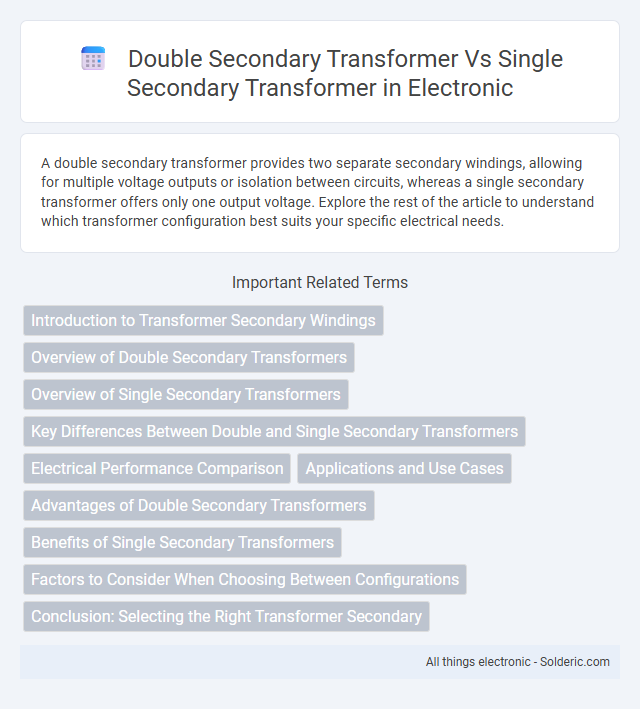A double secondary transformer provides two separate secondary windings, allowing for multiple voltage outputs or isolation between circuits, whereas a single secondary transformer offers only one output voltage. Explore the rest of the article to understand which transformer configuration best suits your specific electrical needs.
Comparison Table
| Feature | Double Secondary Transformer | Single Secondary Transformer |
|---|---|---|
| Secondary Windings | Two separate secondary windings | One secondary winding |
| Output Voltages | Multiple voltages available simultaneously | Single voltage output |
| Applications | Devices requiring dual voltages or isolation | Standard voltage supply needs |
| Complexity | More complex design and cost | Simpler and more cost-effective |
| Isolation | Provides electrical isolation between secondaries | No isolation within secondary |
| Flexibility | Greater flexibility for different load requirements | Limited flexibility |
Introduction to Transformer Secondary Windings
Transformer secondary windings can be configured as single or double, affecting voltage regulation and load distribution. A single secondary transformer features one winding delivering a specific output voltage, suitable for straightforward applications with consistent load demands. Double secondary transformers include two separate windings, enabling multiple voltage outputs or improved load balancing, enhancing versatility in complex electrical systems.
Overview of Double Secondary Transformers
Double secondary transformers feature two independent secondary windings that allow for multiple voltage outputs, enhancing versatility in electrical applications. This design improves load management and isolation between circuits, reducing interference and increasing overall system reliability. Your choice of transformer can benefit from these dual outputs when separate power supplies or varied voltage levels are necessary within the same device.
Overview of Single Secondary Transformers
A single secondary transformer features one secondary winding, providing a specific output voltage suitable for straightforward electrical applications, such as residential power supply. It offers simplicity in design, lower cost, and ease of maintenance, making it ideal for systems where only one voltage output is required. Compared to double secondary transformers, single secondary transformers typically have lower complexity but less versatility in delivering multiple voltage outputs simultaneously.
Key Differences Between Double and Single Secondary Transformers
Double secondary transformers feature two separate secondary windings that allow for multiple voltage outputs or isolation between circuits, whereas single secondary transformers provide only one output voltage. The double winding design enhances flexibility and versatility in applications requiring different voltage levels or isolation. Your choice depends on whether your project needs multiple voltages or simplified design with a single output.
Electrical Performance Comparison
Double secondary transformers provide enhanced electrical performance by delivering multiple voltage outputs from a single core, improving flexibility and efficiency in power distribution. Single secondary transformers supply one fixed voltage output, which may limit capability in applications requiring diverse voltage levels. The presence of two secondary windings reduces load imbalance and enables better voltage regulation, making double secondary transformers advantageous for complex electrical systems.
Applications and Use Cases
Double secondary transformers offer enhanced versatility in applications requiring multiple voltage outputs, such as industrial automation systems and complex power distribution networks. Single secondary transformers are ideal for straightforward, low-demand scenarios like household appliances and simple lighting circuits, where only one voltage level is necessary. Your choice depends on the complexity and flexibility needed in the power supply design for specific use cases.
Advantages of Double Secondary Transformers
Double secondary transformers provide enhanced flexibility by delivering multiple voltages from a single unit, which simplifies wiring and reduces equipment needs. These transformers improve system reliability by isolating circuits, minimizing the risk of faults affecting the entire system. You benefit from cost savings and more efficient space utilization in electrical installations when choosing double secondary transformers over single secondary types.
Benefits of Single Secondary Transformers
Single secondary transformers offer simplified design and reduced costs compared to double secondary transformers, making them ideal for applications requiring a single, consistent voltage output. Their streamlined construction leads to lower maintenance needs and enhanced reliability in your electrical systems. Choosing single secondary transformers can improve efficiency without compromising performance in straightforward power distribution setups.
Factors to Consider When Choosing Between Configurations
Choosing between a double secondary transformer and a single secondary transformer depends on factors such as load requirements, voltage flexibility, and system complexity. Double secondary transformers offer enhanced voltage options and redundancy for critical applications, while single secondary transformers provide simplicity and cost-efficiency for stable, uniform loads. Evaluating the application's power distribution needs and future scalability is crucial to determine the most suitable transformer configuration.
Conclusion: Selecting the Right Transformer Secondary
Choosing between a double secondary transformer and a single secondary transformer depends on your specific application requirements, such as voltage flexibility and isolation needs. Double secondary transformers offer versatile voltage outputs and enhanced safety through isolation, making them ideal for complex electrical systems. Single secondary transformers provide simplicity and cost-effectiveness for straightforward power distribution where multiple voltage levels are unnecessary.
double secondary transformer vs single secondary transformer Infographic

 solderic.com
solderic.com